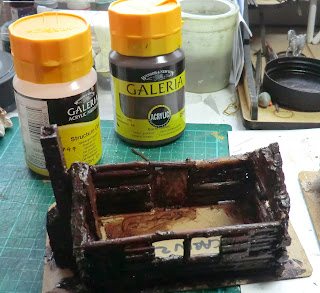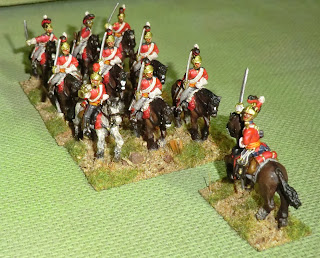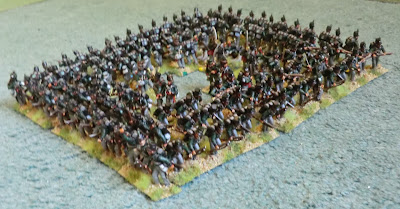When I've made big battalions before they were roughly 60-figure units for my 18th century Imagi-nation armies and were generally built up in stages. Half of our summer-long Waterloo project involves weekend refights round Hougoumont and La Haye Sainte at a 1:3 figure:man scale. Please see the
previous two posts if you are new to this blog. That means battalions of between about 150 to 200 figures. I've volunteered to do four of them for the LHS games and thought it would make sense to start off with the "stars of the show" who held LHS throughout, Major Baring's 2nd Light Battalion of The King's German Legion. Since they were a very understrength unit they would be the smallest part of my madness, working out, in the end, at 138 figures. Essentially they were like the 95th Rifles but with subtle differences. Before I embark on the story of their creation here's a quick look at the lot in line with skirmishers out.

Why 138? In the first rush of enthusiasm I noted the starting strength of 400, divided it roughly by 3 so about 135, and thought "6 companies of 20 figures each, plus command" that sounds neat. I ordered 60 x 2 figure plastic sprues of British Riflemen from Perry's and then realised how attractive the metal Hanoverian command pack was with 6 different figures, 2 officers, 2 sergeants and 2 buglers. But I would need 2 or 3 for each company to make my 135 and had to order 3 packs...so why not use them all, hence 138, and just to be equal each company has 23 figures. So blame History and Perry's for a non-standard size!
For those not familiar with these figures here's a photo of two identical sprues, front and back.
You can imagine that assembing 120 risked getting a bit tedious but I worked out a system. It seemed to me that by matching two different sets of leg/torso with two different sets of arms/rifles I could make four variations and so one for each of four of my companies. This left one company to throw together as "random" and another entirely of conversions, some of them very extensive, if not particularly anatomically sound :-)
These photos show some of the conversions and some of the metal command figures.
I didn't use Greenstuff or modelling putty as filler but brushed on different thicknesses of my favourite Acrylic Structure Gel till I was happy with the result. It dries fairly quickly and is like liquid plastic. You'll also see that I like to base my figures before painting, as it's quicker and easier I think. My watchword for wargame standard painting is "if you can't get to it to paint you probably don't need to!"
I assembled the whole 138 and then sprayed them with Army Painter "Army Green" primer. I wasn't botherting with highlights for so many figures and Army Green is a medium shade, so I then diluted some Citadel "Caliban Green" and gave them all a wash with a big brush. When dry that had a nice effect of filling in the creases and making the ensemble appear a pleasing Rifle Green. Incidentally, the manager at Gloucester Games Workshop surprised me by his historical knowledge and recommended this colour for my "Rifles".

It was now a long slog to do the proper painting with brushes. I'm a child of the Don Featherstone "quick fire" method of figure painting. That is - do the most obvious colours first and go through the whole lot with that colour, then gradually move on to the detail, but still do the whole lot to keep them in sync. I've also read good advice that says if you have a large number the same then break them down into manageable chunks and let each chunk be a stage or two behind the previous, to minimise boredom. Well, as I said in my first of these Waterloo postings, this is a new challenge to me and I wasn't going to fall at the first hurdle so I took it as a matter of honour to carry on regardless with all 138 in the same sequence. My concession to numbers was that, instead of each "colour" I painted each "item" throughout. So 138 black collars, then 276 black cuffs etc. This does cut down on the thinking and changing brush strokes time. I won't bore you with the stages but here they are finished and before the "marmite" stage.

Love it or hate it Army Painter Quickshade Strong Tone is less like Marmite and more like Bovril!
But it certainly brought the plain grey trousers to life, without any other shading or highlighting, and gave the green jackets an extra darken which I think is appropriate. The black leather remains unhighlighted except where the light catches it naturally, but hey, it's 138 model soldiers for wargaming I'm doing here, not a diorama!
Just the bases to landscape and then a good matt spray varnish. Though there were one or two other details that I will show below.
Here are two more views of the battalion in two rank line. Sharp eyed viewers wil realise I have not yet painted Major Baring himself - I need to find or convert a suitable mounted officer in bicorne hat with a lacy Rifle-type jacket and legwear...plenty of time yet.
The five company line is around 36 inches long, or about 110 metres on our ground scale.
And here they are in square
Since sister unit 1st Light battalion KGL (less 2 companies) spent a fair bit of time at Waterloo in square it was good practice for me to see what that might look like. Also in our game we will be having at least 5th (line) Battalion KGL and the British 32nd Foot on the ridge above LHS at some stage, and they are both bigger.
Practically speaking at this scale 3 ranks deep of figures has to represent the classic four-deep British square. I've put the command stands in the centre which can pass as a sort of fourth rank if required. This amount of figures covers roughly 10 inches by 12 inches (30 x 36 metres).
Now here are some photos of my 2LB KGL alongside Kevin's model of La Haye Sainte by Hovels. It's fair to say that if he hadn't already had this model we might not be doing this project at all. Obvioulsy he's just kindly lent it to me for this photo session and we will be putting it on a specially landscaped board for the actual event in 2015.
I'm happy that we've got the scale right. For the photos I've notionally put two companies defending the rear kitchen garden perimeter, a company on the South side where the orchard will be, and three companies within the farm itself. In fact as the buildings have hollow bases one can put a whole company worth of figures in each of the barn, stables and house. For the sake of playability some concessions will have to be made about how many rifles can actually fire out; in real life the lines of fire were quite restricted as few loopholes were made.
Here are some close-ups within the farm
On the piggery and at the main gate. (I made these individual conversions before I saw the model and hoped they would fit on what I thought was a flat roof ----doooooh!)
This is the stable block and the passageway through to the West side
In the last posting I waxed lyrical about the superb "95" decals available from Alban Miniatures and I decided, as I had transfer paper for my printer, to make some of my own for 2LB KGL. I have some of the wonderful re-enactor photo books in the "Europa Militaria Special" series. Nr. 9, on German Napoleonic Armies, has a good feature on The KGL Light and here is a detail of equipment.
The back pack has a nice green horn on its side and I was able to copy that, modify it in the computer and produce some about 2mm square for the centre of my backpacks.
That isn't just modelling nerdyness as I'm trying to think of distinguishing features on the table top to help players. In my game there might be up to 700 figures in dark green jackets from 4 different battalions. With your specs on you
can see the "2" on these backpacks! I also produced some little transfers for the water canteens but these proved to be more of a liability and a waste of time, so I won't be doing them for other units.
Each company, bar the first, is distinguished by a small coloured blob of paint on the base - white, green, red, yellow and light blue and also a sticky label underneath each base to identify which company.
With any luck none of our players will be able to claim they can't track casualties as they can't distinguish companies and battalions apart.
I hope that's been of interest or some use. Next on the painting table a complete change doing my first 10 figures of one of the two squadrons of the 2nd Life Guards.


















































